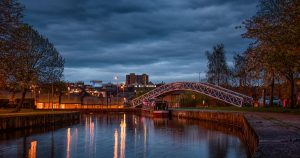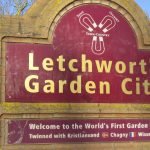Stoke-on-Trent, commonly just referred to as “Stoke”, is a city that is situated in Staffordshire, part of Englands West Midlands. It’s neither North nor South, which causes some controversy among the thousands of students that come from all over the world to study here. But Stoke is also known by another name: The Potteries.

History of Stoke!
Stoke hasn’t been around as long as many of the other cities and towns in England. In fact, Stoke as we know it didn’t exist until the 20th century. The city of Stoke-on-Trent didn’t come into being until March of 1910, with the Federation of the Six Towns. The six towns were Burslem, Fenton, Hanley, Longton, Stoke and Tunstall.
However, history does show that there were settlements that were scattered throughout the Stoke area for thousands of years prior to “Stoke-on-Trent” or “The Federation of the Six Towns” having their own records.
The first records of Hanley’s existence in England appeared back in 1227. This is still much later than other towns or cities around the same area. Hanley was known in the 13th century as “Hanlih”, and it was nothing more than a tiny village. Evidence of both coal mining and ironworking in Tunstall, another of the six towns, dates back to the 13th century, as well. So, we know that the area had people living and working inside of it. Throughout the Middle Ages, these settlements remained as villages; it wasn’t until a few centuries later than we saw a hint of what Stoke-on-Trent would be.
Over to the mid-17th century, we see a small community of farmers and potters establishing themselves in the Stoke area. They made pots for butter made in Burslem, which is why many regard Burslem to be the beginning of pottery in the area. Potters started setting up small factories in Hanley, Stoke, and Tunstall, as well as in Fenton and Longton. By 1740, a substantial industry of pottery had grown within the six towns.
Clay that was gathered from the local area would fire with a red tone, which wasn’t ideal and wasn’t as desirable. Potters eventually switched to clay that would be brought in from south-west England and was white in colour, rather than red.
Wedgewood Fine China
Josiah Wedgewood set up his business in 1759, with Josiah Spode following suit in 1767. After this, we saw the rise of Minton, Aynsley, and Doulton, as well. An interesting fact here is that the Stoke campus of Staffordshire University used these potters’ names as the names of their on-site accommodation buildings. First-year students stay in flats together under buildings with the names that made the Potteries what they are today.
Stoke-on-Trent’s Trent and Mersey Canal was finished in 1777, even though it was authorised to be built in 1766. That’s eleven years, 70 locks, and five tunnels. However, the railway station was completed in 1848, making the use of the canal obsolete as a faster service took over. The canal is still one of the most picturesque views around the city, with its winding waters leading the public through many green areas of Stoke.
By the time the railway was ready to go, the villages had become small, but sizable, towns. Burslem, of course, was still the largest. The population continued to grow, and we saw the rise of football in Stoke; with Stoke City Football Club being established in the 1860s.
A federation of the towns had been proposed in 1888. However, it wasn’t until 1910 that the six towns were officially amalgamated, and Hanley was named as its centre. In 1925, Stoke finally achieved city status.
Stoke is still at the forefront of the ceramics industry in England. Still famous for its tableware, its tiles, and other pottery work; with most of the original population of the newly named city working in pottery factories, it isn’t a surprise that so many families in the city still remember its history. Although the industry has declined in this modern age, the Emma Bridgewater company’s move to the city did rekindle the life of pottery in Stoke for a while.
Today, Stoke looks towards the future, but it is a city that is steeped in history and culture and a true lover of the arts.
What to do in Stoke!
At first, Stoke doesn’t seem like it has much to offer beyond is historic Potteries background, but that’s no so! Stoke-on-Trent is a city that is always developing, and there are plenty of events year-round, as well as amazing facilities that you can go to. Waterworld is right outside of Hanley city centre, while Trentham Gardens has a shopping village that is full of independent retailers and eateries that would welcome your visit.
Shopping
Each of the six towns that make up Stoke-on-Trent has their own high streets and market areas. The most popular place to go is the Intu Potteries Shopping Centre in Hanley centre – which is the city centre of Stoke-on-Trent. This is the closest shopping centre to the main area of Stoke, and around a 30-minute walk from Stoke Railway Station.
The Intu Potteries Centre is full of brand name stores, including H. Samuel, Claire’s, Primark, Superdrug, and more. The shopping centre is surrounded on all sides by streets full of other stores, too. You could easily spend a few hours shopping in Hanley centre. Thankfully, there are also plenty of places to eat, too. And there are two cinemas within walking distance of the city centre!
Food and Drink
Stoke-on-Trent invests in its future. A few years ago, the city built a new centre called “The Hive”, which sits behind the Intu Potteries Shopping Centre. The Hive is the home to several eateries and a sparkling Cineworld. You can find Nando’s directly underneath the buffet powerhouse that is Bon Pan Asian; a contemporary pan-Asian restaurant that serves everything from sushi to standard Chinese food.
Stoke is full to the brim with takeaway restaurants, too. They’ll deliver to anywhere, as long as they can get to you. Including deliveries to the University dorms or its buildings; trust us, it’s been done. With Uber also comes Uber Eats; so, you have that option, too.
Restaurants are everywhere in Stoke, but you’ll find that some of the most popular ones here are the pubs and the Weatherspoon’s that are dotted around. But for fine dining, why not head down to Newcastle-under-Lyme and try the European wonders of Marloes? Or if you’d rather stay central and close to Hanley, Portofino is a stunning Italian restaurant with a great menu.
Music and Entertainment
Two of the most popular live music and clubbing venues in Stoke-on-Trent are The Sugarmill and The Underground. Both are located in Hanley city centre and are just a few minutes’ walk away from one another. If you continued up the street, back towards the high street, you’d also come across many of Hanley’s other clubs that are open almost every night.
As for non-alcohol-based music adventures, Stoke is also home to several theatres. Within Hanley, there are The Regent Theatre, New Vic Theatre, and Victoria Hall. All three of these theatres offer everything from live music to theatre performances; including sing-a-longs and comedy nights.
But if you fancy getting away from the bustle of the town for a little while, head down to Festival Park. There’s a Ten Pin there with its own small arcade, and it’s practically next door to the Odeon Cinema. You could easily stay there for a night out with a group of friends or with your children.
Travelling in Stoke!
Travelling in Stoke-on-Trent couldn’t be easier! With just the one railway station, you’ll know exactly where you are when you leave the station, but from there, it can be confusing to new visitors. Stoke mainly runs on a system of buses and taxis. Uber has increased their presence in the city over the past year or two, and it’s very easy to book one of their many cars now. Alternatively, there are several other companies – such as A1 and Lucky Seven – that have been serving the city for many years.
As for buses, First Bus and D&G are the main services in Stoke. With buses running every few minutes at most stops. Services are slower and less frequent as it gets towards 6 pm and on the weekends. It’s also harder to travel on bank holidays. For a single ticket on a First bus service, expect to pay around £2.20 for an adult. Day riders are £5.50. D&G is cheaper than First Bus in most cases, especially for students, but they have significantly fewer services all prices in 2019).
The entirety of Stoke is much bigger than it seems. If you’re staying in Stoke or Hanley, walking around is definitely an option. But if you’re touring all six towns of Stoke, buses are your best friend.
Places to stay in Stoke!
There aren’t too many hotels around Stoke-on-Trent, which is actually quite helpful when you’re looking for somewhere to stay. As we’ve mentioned, many regard this city as a city of students, and there isn’t much call for chain hotels.
One of the main hotels used is literally across the road from the train station. Stoke Railway Station brings traffic in from the North and from the South; with direct links to Manchester, Birmingham, London, and many cities in between. It sits on a mainline, so most people end up passing through. The hotel is the North Stafford Hotel, which is ironic because Stafford is about half an hour outside of Stoke-on-Trent, and Stoke isn’t exactly North of Stafford, either.
The North Stafford Hotel is run by the Britannia Hotels company, and averages around £40 a night. Its convenient location is definitely one of its biggest selling points.
Other than the North Stafford Hotel, there are two Best Western hotels in the area; one a stone’s throw away from the high street shops and all the clubs in Hanley town centre, and another just outside of Hanley, near Waterworld. There is also hosts a Holiday Inn express.
As for Air BnBs in the area, there are a few more places to stay than one would imagine. Stoke is very inexpensive for accommodation, so visitors are looking at between £20 and £40 a night on average. However, you are more likely to find a private room on offer than anything larger.
So there we have it our quick guide to Stoke-on-Trent which is so much more than just a pottery town. Before you go why not have a look at some of our other guides or try one of our quizzes.



